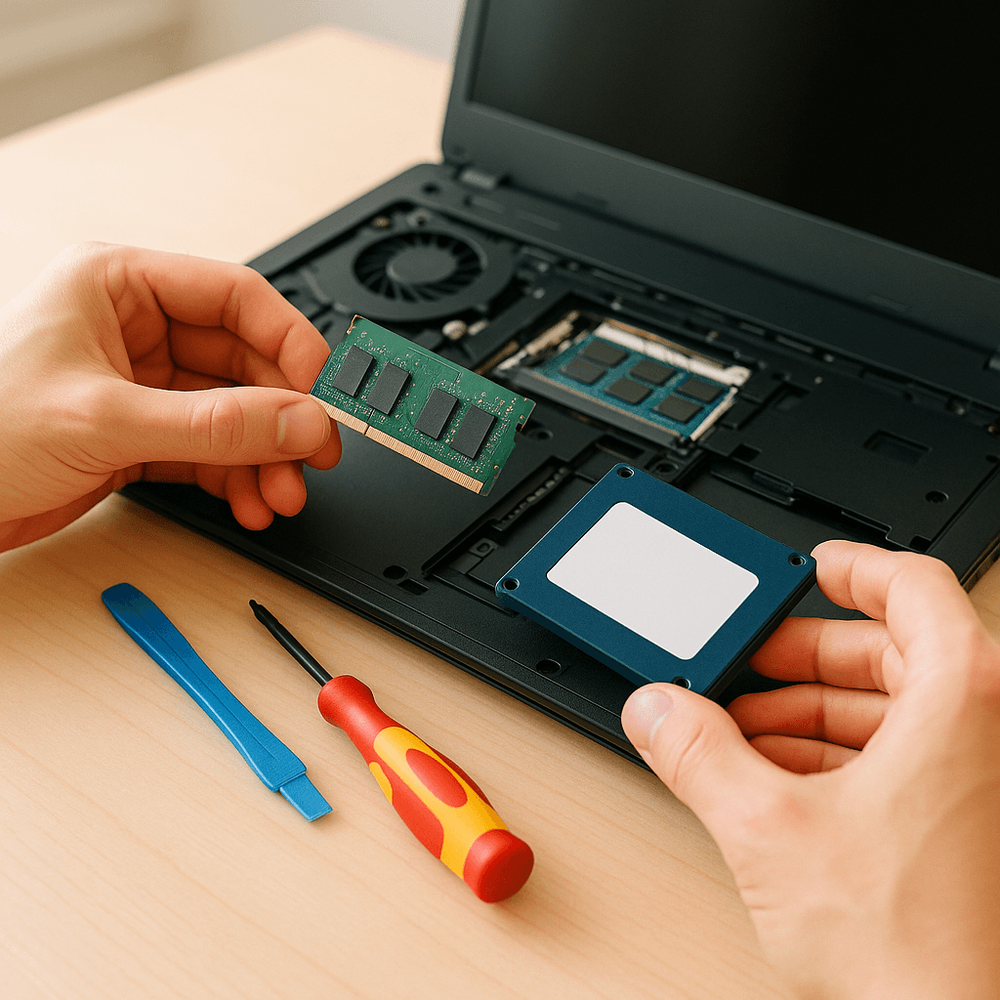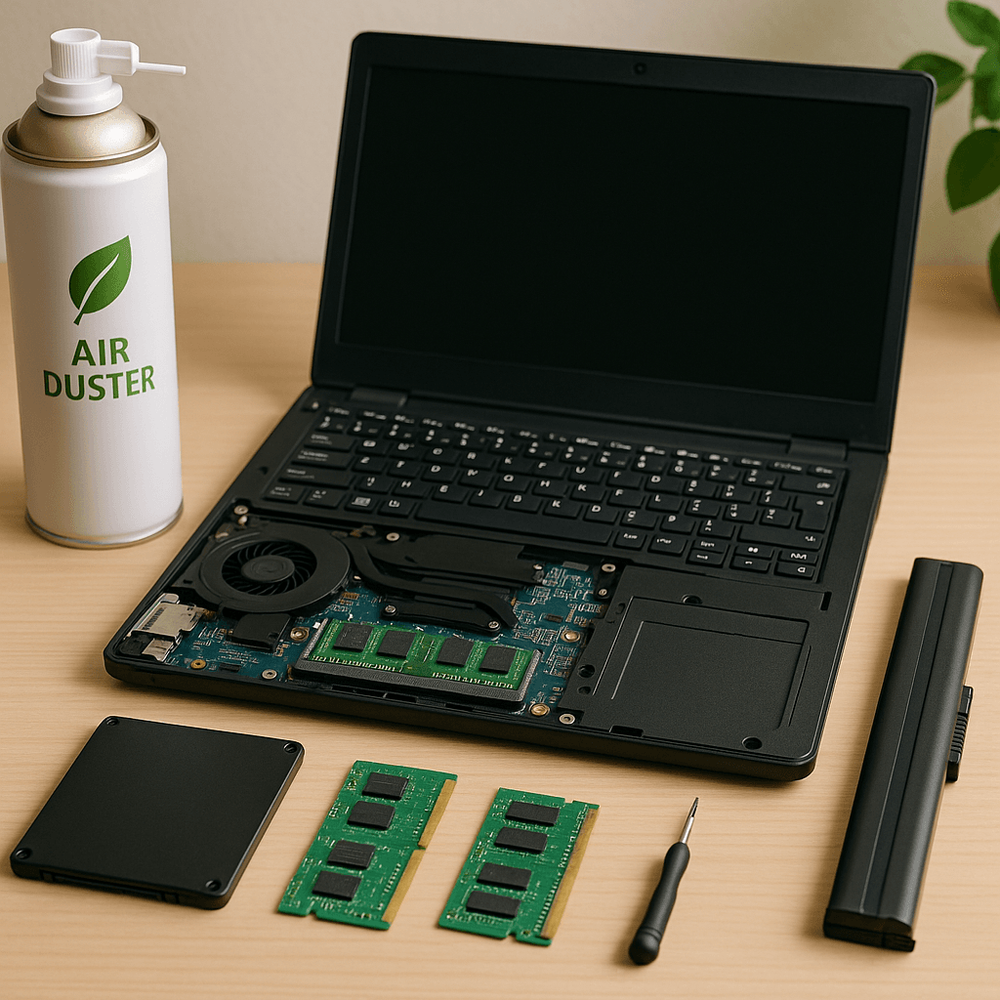Transform Your Old Laptop: The Top 2 Upgrades Anyone Can Do for Under $50 (No Tech Skills Needed)
Transform Your Old Laptop: The Top 2 Upgrades Anyone Can Do for Under $50 (No Tech Skills Needed)

Introduction: Why Bother to Upgrade an Old Laptop?
Is your laptop not running well—taking forever to start, freezing up, or struggling with multiple tabs open? Before you spend hundreds on a replacement, consider a cost-effective laptop fix: upgrading your old laptop with simple hardware swaps.
Affordable laptop upgrades can dramatically increase laptop performance, delivering lightning-fast boot times and smoother multitasking. The best cheap laptop upgrades—an SSD and more RAM—help fix laggy laptops and extend their usable life, giving a second life for old laptops.
Upgrading instead of replacing is smart for your wallet and for the planet. Revitalizing an aging laptop lets you keep using it for years, reduces e-waste, and results in clear financial benefits of laptop upgrades. If you want to maximize laptop lifespan and speed up a slow laptop without advanced skills, these solutions are for you.
Step 1: The SSD Revolution — The Single Biggest Speed Boost

If there's one upgrade that will instantly transform a slow laptop, it's installing an SSD in your laptop. Replacing the laptop hard drive (HDD) with a solid-state drive brings a dramatic speed boost—often making a laptop 10x to 20x faster.
Why Install an SSD in Your Laptop?
- SSD vs HDD for laptops: SSDs have no moving parts, so they access data almost instantly. This slashes boot times and fixes slow startup.
- Real user reports on forums and Reddit say even basic SSD upgrades make an "unusable" laptop feel brand new.
- Benefits of SSD upgrade: Enjoy faster program launches, improved laptop boot time, and fix laggy laptops with just this one change.
Choosing an Affordable SSD Option
- Best SSD for old laptop: Stick to 240–500GB models—enough for most users. Brands like Crucial, Kingston, and Western Digital give great value.
- Entry-level SSD suggestions: Expect to pay $25–$50 for a quality SSD. These brands repeatedly score highest in community tests and pro reviews.
- Storage upgrade laptop checklist:
- Confirm compatibility (most older laptops use SATA; newer ones might use NVMe).
- Backup your data before upgrading.
- Gather simple tools: a small screwdriver and a plastic pry tool.
How to Upgrade Laptop Storage: Step-by-Step
- Power down and unplug the laptop.
- Remove the battery if possible.
- Open the bottom panel (usually a few screws).
- Carefully remove the old hard drive.
- Insert the new SSD securely.
- Replace the panel and battery.
Tip: Find a laptop opening tutorial video for your specific model for extra confidence.
User-Friendly SSD Migration Tools
- To keep your files: Use free cloning software to copy everything from your old drive onto the SSD.
- For the most speed: Do a clean reinstall of Windows after replacing the laptop hard drive.
- Adding storage to laptop: Pop your old HDD into a $10 USB enclosure for portable storage for laptops and future backup.
Safety Reminder: Always back up important data before any hardware upgrade. Work slowly and gently; most DIY laptop upgrades are safer than you think.
Expert note: Reddit users and hardware experts agree—installing an SSD in your laptop is the single most effective performance boost, even for beginners. It's often the best cheap laptop upgrade for aging devices.
Step 2: Upgrade Laptop RAM — Unleash Smooth Multitasking

Can't open more than a few tabs or apps before your laptop freezes? If your laptop not running well, upgrading laptop RAM is your next best fix. This often brings major multitasking improvements and snappier performance.
Why Upgrade Laptop RAM?
- More RAM = smoother multitasking: An upgrade from 4GB to 8GB (or 16GB if possible) is one of the best cheap laptop upgrades you can make to fix laggy laptops and keep up with modern apps.
- Laptop performance improvements: You'll experience fewer slowdowns switching between browsers, streaming, video calls, or student/office tasks.
Laptop Memory Upgrade Guide
- Find out your laptop RAM compatibility—look up your laptop model plus "RAM compatibility" to see if you need DDR3 or DDR4.
- Choosing laptop RAM: For web and office use, 8GB is the sweet spot. Generic brands work fine if you match specs.
- Recommended RAM size: 8GB for daily use, 16GB for coding/design, but even going from 4GB to 8GB makes a huge difference.
- Cheap RAM upgrades: 4–8GB modules usually cost $20–$40.
How to Upgrade Laptop RAM: Step-by-Step
- Power off and unplug your laptop. Remove battery if possible.
- Open the RAM access panel (usually underneath).
- Release side clips, remove old RAM, and insert the new stick(s).
- Replace the cover and battery, turn on, and enjoy.
Tip: Watching a quick laptop opening tutorial makes first-timers more confident.
Troubleshooting: If the laptop not running well after the upgrade, reseat the RAM. Try one stick at a time to find faulty parts.
Who benefits most? Students, remote workers, and anyone who keeps lots of browser tabs or documents open will notice massive improvements—especially when upgrading both RAM and SSD.
Pro Tips: Bonus Upgrades and Essential Maintenance for Old Laptops
To extend laptop life even further, add these simple laptop maintenance tips to your upgrade checklist:
- Cleaning laptop internals: Remove dust from vents and fans with a can of air. This lowers heat and reduces noise.
- Thermal paste replacement laptop: Adding new thermal paste ($5–10) to your CPU keeps your laptop from overheating—essential for older models.
- Optimize laptop battery life: Lower screen brightness, close unused apps, and disable unused features to get more life from your battery. If it won’t hold charge, it’s time to replace laptop battery.
- Regular maintenance: Clean internals twice a year and consider a cooling pad if your laptop gets hot.
- Laptop BIOS update: After hardware upgrades, update your BIOS and drivers for best stability.
- Improving laptop graphics: Most laptops can’t upgrade graphics chips, but keeping drivers updated, reducing dust, and using a cooling pad helps performance for older hardware.
- Undervolting tips: Advanced users can undervolt to reduce laptop heat and noise, especially helpful for power users.
Essential laptop tools: All you really need for most upgrades is a basic screwdriver and patience.
Eco-friendly tip: Routine maintenance and eco-friendly laptop upgrades help keep devices out of landfills, reducing waste and saving money.
Make Software Work for You: Simple Tweaks After Hardware Upgrades
Upgrading hardware is only half of the fix. To fully restore laptop to factory speed:
- Reinstalling Windows after upgrade: A clean OS install gets rid of software clutter, boosting performance and stability. Use the Microsoft Media Creation Tool for an easy, official USB install.
- Try a lightweight Linux for old laptops: Distros like Linux Mint or Ubuntu XFCE work wonders, especially if your laptop was laggy even before. These are extremely resource-friendly alternatives proven to increase laptop performance on older devices.
- Dual boot old laptop: Want both worlds? Set up Windows and Linux for flexible use.
- Laptop software cleanup: Uninstall unused programs, run disk cleanup, and disable unnecessary startup programs.
- Keep drivers updated: After upgrades, install the latest drivers from your laptop brand’s support page.
- Troubleshooting: If you notice high disk usage, scan for malware and close background tasks. These small software fixes help you run modern apps on old laptop hardware.
Editor’s note: Every hardware upgrade is magnified by fresh software—a combo that can rival new laptops at a fraction of the price.
Laptop Upgrade Success Stories: Real-World Examples
Thousands have revitalized aging laptops with these cost-effective laptop fixes. Real-world results show how the best cheap laptop upgrades can boost laptop speed and maximize laptop lifespan—even for non-techies.
Actual User Stories
- Students: Upgrading RAM and installing an SSD in a laptop turned an “unusable” school computer into a fast, reliable study tool.
- Home & Office: Many families find that upgrading an old ThinkPad or EliteBook delivers better value than buying new.
- Creative Uses: Old laptops with new SSDs are transformed into home servers, streaming boxes, or beginner coding platforms.
- Reddit highlights: Community members consistently say, "I wish I’d done this years ago" after their first DIY laptop upgrade.
Common Myths & Troubleshooting
- Most upgrades are plug-and-play. If your laptop not running well after the upgrade, double-check connections (especially RAM) and consult beginner guides.
- Typical risks: Bent connectors or mismatched parts. These are rare and easily avoided by taking your time and double-checking compatibility.
- Fun upcycling: Repurpose older laptops for digital photo frames, Pi-hole ad blockers, or secure learning stations for kids.
If a device truly can’t be saved, recycle old laptop components responsibly.
FAQs: Your Top Questions About Revitalizing Aging Laptops Answered
Q: How can I create a laptop upgrade checklist?
A: Start by identifying compatible laptop parts (look up your model’s RAM and SSD type), back up your data, and gather tools. Decide on your best cheap laptop upgrades, then follow step-by-step guides.
Q: How do I find compatible laptop parts?
A: Search “[your laptop model] RAM compatibility” or “[model] SSD type.” Most brands provide official specs, and communities online can help.
Q: Are used laptop parts safe?
A: Yes, especially RAM and SSDs. Many users find cheap upgrades at e-waste centers or online.
Q: What tools are required for DIY laptop upgrades?
A: Usually just a small Phillips screwdriver and a plastic pry tool. Always unplug and work gently.
Q: Can I upgrade the processor or graphics?
A: In most laptops, CPU and GPU upgrades aren’t practical. Focus on RAM and SSD for real improvement.
Q: Is gaming possible on an old laptop after upgrades?
A: Light games will run much better. For heavier titles, external monitors and reducing graphics settings can help.
Q: How can I add more storage to my laptop?
A: Upgrade your internal SSD or use portable SSDs/external drives. Cloud storage is another option for infrequently accessed files.
Q: What should I do if the laptop is not running well after upgrades?
A: Reseat RAM, double-check SSD cables, or try your old parts. Most issues are simple fixes.
Q: Will a screen upgrade help?
A: Most laptop screens are not easy to swap, but external monitors work well for improved displays.
Conclusion: Is It Worth Upgrading an Old Laptop in 2025?
Absolutely—doing a couple of the best cheap laptop upgrades can completely boost laptop speed, improve laptop performance, and give you a second life for old laptops. For under $50, even non-techies can fix laggy laptops, increase laptop performance, and maximize laptop lifespan—no expensive trips to the repair shop required.
DIY laptop upgrades are a cost-effective laptop fix that save money, reduce e-waste, and extend the value of your investment, especially for students, remote workers, and everyday users.
If your laptop not running well, don’t give up. With a simple SSD and RAM upgrade, you can revitalize aging laptops and enjoy years of smoother, frustration-free use. It’s a decision that benefits you, your wallet, and the planet.
Resources, Tutorials & Further Reading
Looking for more step-by-step help? These beginner-friendly resources and community threads offer detailed laptop hardware upgrades, DIY laptop upgrade checklists, and older laptop upgrade tips:
- Beginner’s how-to-upgrade RAM
- Corporate laptops: Upgrade stories & tips
- Laptop hardware upgrades explained—by users
- Linux on old laptops: Success stories
Also, check your manufacturer’s support page for a laptop opening tutorial matched to your model, and review detailed laptop maintenance tips from trusted communities.
With compatible laptop parts, a screwdriver, and a little time, you can join the thousands who have already upgraded their devices successfully. Enjoy your faster laptop—you’ve earned it!
Editorial advisory: Always research compatible laptop parts before you buy, and don’t hesitate to reach out to online communities for help or troubleshooting. These small upgrades can deliver big results—making your laptop run like new and extending its useful life for years to come.